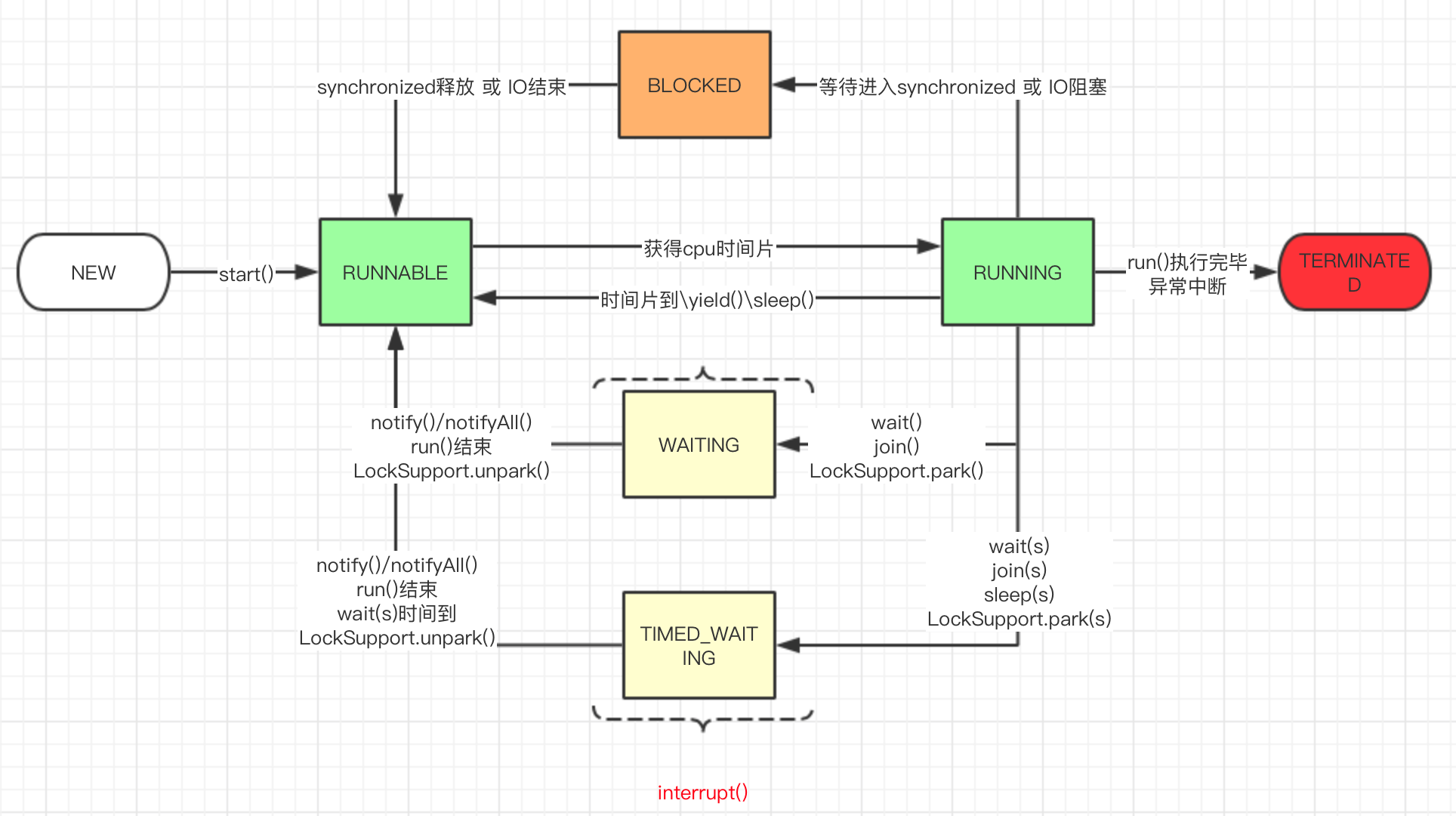我看JAVA 之 Thread & ThreadLocal
我看JAVA 之 Thread & ThreadLocal
注:基于jdk11
Thread
Thread是程序里执行的一个线程。JVM允许一个应用程序中可以有多个线程并发执行。
每一个线程都有一个优先级,高优先级的线程优于低优先级的线程先执行。同时,线程还可以被标记为守护线程。线程在被创建的时候优先级默认等同于创建者的优先级。
创建一个Thread通常有如下几种方式:
-
继承Thread类,重写run()方法
public class ConcreteThread extends Thread(){ public void run() { .... } } new ConcreteThread().start() -
实现Runnable接口,重写run()方法
public class ConcreteThread implements Runnable(){ public void run() { .... } } new ConcreteThread().start() -
匿名类方式
new Thread(new Runnable() { public void run() { .... } }).start()
实现了如下接口
- Runnable 被FunctionalInterface注解的接口,定义了public abstract void run()方法供子类去实现。
几个重要的成员变量
- private volatile String name; 被volatile修饰的name,每个线程必须有一个唯一的名字,方便调试,一般为 Thread-nextThreadNum()
- private boolean daemon = false; 是否守护进程,默认为否
- private boolean stillborn = false;
- private long eetop;
- private Runnable target; 执行目标
- private ThreadGroup group; 线程组,默认为ecurity.getThreadGroup() 或 父线程所在组
- private ClassLoader contextClassLoader;
- private AccessControlContext inheritedAccessControlContext;
- private static int threadInitNumber; 与Thread-拼接构成线程默认名称,private static synchronized int nextThreadNum()对其递增threadInitNumber++
- ThreadLocal.ThreadLocalMap threadLocals = null;
- ThreadLocal.ThreadLocalMap inheritableThreadLocals = null;
- private final long stackSize; 为当前线程申请的栈空间,默认为0,取决于vm设计实现,有些vm会直接忽略此配置
- private long nativeParkEventPointer;
- private final long tid; 当前线程ID
- private static long threadSeqNumber; 线程id计数器,private static synchronized long nextThreadID()对其递增++threadSeqNumber
- private volatile int threadStatus;
- volatile Object parkBlocker;
- private volatile Interruptible blocker;
- private final Object blockerLock = new Object();
- public static final int MIN_PRIORITY = 1; 线程可以设置的最小优先级
public static final int NORM_PRIORITY = 5;线程默认优先级
public static final int MAX_PRIORITY = 10;线程可以设置的最大优先级
线程的优先级会对应到不同操作系统的优先级,JVM不一定设置的优先级进行线程调度 - 异常处理相关
//当前线程异常处理handler,由volatile修饰
private volatile UncaughtExceptionHandler uncaughtExceptionHandler;
//所有线程缺省异常处理handler,由static volatile修饰
private static volatile UncaughtExceptionHandler defaultUncaughtExceptionHandler;
几个重要的方法
-
启动线程,JVM会调用当前线程的run方法
public synchronized void start() { /** * This method is not invoked for the main method thread or "system" * group threads created/set up by the VM. Any new functionality added * to this method in the future may have to also be added to the VM. * * A zero status value corresponds to state "NEW". */ if (threadStatus != 0) throw new IllegalThreadStateException(); /* Notify the group that this thread is about to be started * so that it can be added to the group's list of threads * and the group's unstarted count can be decremented. */ group.add(this); boolean started = false; try { start0(); started = true; } finally { try { if (!started) { group.threadStartFailed(this); } } catch (Throwable ignore) { /* do nothing. If start0 threw a Throwable then it will be passed up the call stack */ } } } private native void start0(); -
停止线程,已过时
@Deprecated(since="1.2") public final void stop() { SecurityManager security = System.getSecurityManager(); if (security != null) { checkAccess(); if (this != Thread.currentThread()) { security.checkPermission(SecurityConstants.STOP_THREAD_PERMISSION); } } // A zero status value corresponds to "NEW", it can't change to // not-NEW because we hold the lock. if (threadStatus != 0) { resume(); // Wake up thread if it was suspended; no-op otherwise } // The VM can handle all thread states stop0(new ThreadDeath()); } private native void stop0(Object o);stop线程容易导致出现如下两种情况:
- 立即停止run()方法中剩余工作(包括在catch或finally语句),并抛出ThreadDeath异常(通常情况下此异常不需要显示的捕获),可能会导致一些清理性工作的得不到执行,如文件流,数据库连接等的关闭。
- 会立即释放该线程所持有的所有的锁,导致数据得不到同步的处理,出现数据不一致的问题
-
中断
public void interrupt() { if (this != Thread.currentThread()) { checkAccess(); // thread may be blocked in an I/O operation synchronized (blockerLock) { Interruptible b = blocker; if (b != null) { interrupt0(); // set interrupt status b.interrupt(this); return; } } } // set interrupt status interrupt0(); } private native void interrupt0(); public static boolean interrupted() { return currentThread().isInterrupted(true); } private native boolean isInterrupted(boolean ClearInterrupted); -
join 插队并阻塞当前执行线程,使用 loop + wait 的方式实现
public final void join() throws InterruptedException { join(0); } public final synchronized void join(long millis) throws InterruptedException { long base = System.currentTimeMillis(); long now = 0; if (millis < 0) { throw new IllegalArgumentException("timeout value is negative"); } if (millis == 0) { while (isAlive()) { wait(0); } } else { while (isAlive()) { long delay = millis - now; if (delay <= 0) { break; } wait(delay); now = System.currentTimeMillis() - base; } } } public final native boolean isAlive(); -
suspend 与 resume 要成对出现,如果A线程访问某个资源x时suspend(),那么没有任何线程可以访问资源x直到A线程被resume()
@Deprecated(since="1.2") public final void suspend() { checkAccess(); suspend0(); } @Deprecated(since="1.2") public final void resume() { checkAccess(); resume0(); }
线程状态及状态转换
-
状态定义
public enum State { NEW, RUNNABLE, BLOCKED, WAITING, TIMED_WAITING, TERMINATED; } - 状态图
-
例子:
package chapter02; public class TestThread { public static void main(String [] args) throws InterruptedException { final Thread thread0 = new Thread(new Runnable() { @Override public void run() { System.out.println("进入run"); try { System.out.printf("enter run(), thread0' state: %s\n", Thread.currentThread().getState()); Thread.sleep(5000); } catch (InterruptedException e) { e.printStackTrace(); System.out.println("异常处理"); System.out.printf("on catch interrupt, thread0 isInterrupted or not ? %s \n", Thread.currentThread().isInterrupted()); System.out.printf("on catch interrupt, thread0' state: %s\n", Thread.currentThread().getState()); return; } System.out.println("退出run"); } }); Thread thread1 = new Thread(new Runnable() { @Override public void run() { System.out.println("进入thread1's run"); try { Thread.sleep(1000); System.out.printf("before interrupt, thread0 isInterrupted or nott ? %s \n", thread0.isInterrupted()); System.out.printf("enter thread1's run(), thread0' state: %s\n", thread0.getState()); Thread.sleep(1000); thread0.interrupt(); System.out.printf("after interrupt, thread0 isInterrupted or not ? %s \n", thread0.isInterrupted()); } catch (InterruptedException e) { e.printStackTrace(); } System.out.println("退出thread1's run"); } }); System.out.printf("after new(), thread0' state: %s\n", thread0.getState()); thread0.start(); System.out.printf("after start(), thread0' state: %s\n", thread0.getState()); thread1.start(); thread0.join(); System.out.printf("after join(), thread0' state: %s\n", thread0.getState()); System.out.println("退出"); } }打印结果如下:
after new(), thread0' state: NEW after start(), thread0' state: RUNNABLE 进入run enter run(), thread0' state: RUNNABLE 进入thread1's run before interrupt, thread0 isInterrupted or nott ? false enter thread1's run(), thread0' state: TIMED_WAITING after interrupt, thread0 isInterrupted or not ? false 退出thread1's run 异常处理 on catch interrupt, thread0 isInterrupted or not ? false on catch interrupt, thread0' state: RUNNABLE after join(), thread0' state: TERMINATED 退出
异常捕获
- 说明:
//当前线程异常处理handler,由volatile修饰
private volatile UncaughtExceptionHandler uncaughtExceptionHandler;
//所有线程缺省异常处理handler,由static volatile修饰
private static volatile UncaughtExceptionHandler defaultUncaughtExceptionHandler; -
例子:
package chapter02; public class TestThread { public static void main(String [] args) throws InterruptedException { //全局异常处理器 Thread.setDefaultUncaughtExceptionHandler(new Thread.UncaughtExceptionHandler() { @Override public void uncaughtException(Thread t, Throwable e) { System.out.println("-" + Thread.currentThread().getName()); String threadName = t.getName(); System.out.printf("global exception handler >> : current thread's name is %s, ", threadName); System.out.printf("the error is %s \n",e.getLocalizedMessage()); } }); final Thread thread0 = new Thread(new Runnable() { @Override public void run() { System.out.println("进入thread0's run"); System.out.printf("enter run(), thread0' state: %s\n", Thread.currentThread().getState()); try { Thread.sleep(5000); } catch (InterruptedException e) { // e.printStackTrace(); // System.out.println("异常处理"); // System.out.printf("on catch interrupt, thread0 isInterrupted or not ? %s \n", Thread.currentThread().isInterrupted()); // System.out.printf("on catch interrupt, thread0' state: %s\n", Thread.currentThread().getState()); // // return; throw new RuntimeException(e); } System.out.println("退出thread0's run"); } }); //thread0异常处理器 thread0.setUncaughtExceptionHandler(new Thread.UncaughtExceptionHandler() { @Override public void uncaughtException(Thread t, Throwable e) { System.out.println("-" + Thread.currentThread().getName()); String threadName = t.getName(); System.out.printf("thread0 exception handler >> : current thread's name is %s, ", threadName); System.out.printf("the error is %s \n",e.getLocalizedMessage()); } }); Thread thread1 = new Thread(new Runnable() { @Override public void run() { System.out.println("进入thread1's run"); try { Thread.sleep(1000); System.out.printf("before interrupt, thread0 isInterrupted or nott ? %s \n", thread0.isInterrupted()); System.out.printf("enter thread1's run(), thread0' state: %s\n", thread0.getState()); Thread.sleep(1000); thread0.interrupt(); System.out.printf("after interrupt, thread0 isInterrupted or not ? %s \n", thread0.isInterrupted()); Thread.sleep(2000); } catch (InterruptedException e) { e.printStackTrace(); } System.out.println("退出thread1's run"); } }); System.out.printf("after new(), thread0' state: %s\n", thread0.getState()); thread0.start(); System.out.printf("after start(), thread0' state: %s\n", thread0.getState()); thread1.setDaemon(true); thread1.start(); thread0.join(); thread1.join(); System.out.printf("after join(), thread0' state: %s\n", thread0.getState()); System.out.println("退出"); } }打印结果如下:
after new(), thread0' state: NEW after start(), thread0' state: RUNNABLE 进入thread0's run enter run(), thread0' state: RUNNABLE 进入thread1's run before interrupt, thread0 isInterrupted or nott ? false enter thread1's run(), thread0' state: TIMED_WAITING after interrupt, thread0 isInterrupted or not ? true -Thread-0 thread0 exception handler >> : current thread's name is Thread-0, the error is java.lang.InterruptedException: sleep interrupted 退出thread1's run after join(), thread0' state: TERMINATED 退出
ThreadLocal
- 说明:
jdk1.2开始,为解决多线程程序的并发问题提供了一种新的思路ThreadLocal。使用这个工具类可以很简洁地编写出优美的多线程
程序,ThreadLocal并不是一个Thread,而是Thread的局部变量。 -
源码:
public class ThreadLocal<T> { private final int threadLocalHashCode = nextHashCode(); private static AtomicInteger nextHashCode = new AtomicInteger(); private static final int HASH_INCREMENT = 0x61c88647; private static int nextHashCode() { return nextHashCode.getAndAdd(HASH_INCREMENT); } protected T initialValue() { return null; } public static <S> ThreadLocal<S> withInitial(Supplier<? extends S> supplier) { return new SuppliedThreadLocal<>(supplier); } public ThreadLocal() { } public T get() { Thread t = Thread.currentThread(); ThreadLocalMap map = getMap(t); if (map != null) { ThreadLocalMap.Entry e = map.getEntry(this); if (e != null) { @SuppressWarnings("unchecked") T result = (T)e.value; return result; } } return setInitialValue(); } boolean isPresent() { Thread t = Thread.currentThread(); ThreadLocalMap map = getMap(t); return map != null && map.getEntry(this) != null; } private T setInitialValue() { T value = initialValue(); Thread t = Thread.currentThread(); ThreadLocalMap map = getMap(t); if (map != null) { map.set(this, value); } else { createMap(t, value); } if (this instanceof TerminatingThreadLocal) { TerminatingThreadLocal.register((TerminatingThreadLocal<?>) this); } return value; } //设置线程本地值,如果已经存在覆盖,否则为当前线程创建新的ThreadLocalMap,赋值给当前线程的threadLocals局部变量 public void set(T value) { Thread t = Thread.currentThread(); ThreadLocalMap map = getMap(t); if (map != null) { map.set(this, value); } else { createMap(t, value); } } //删除本地值,不调用此方法在线程销毁后jvm也会回收,调用此方法后,如果多次访问get()方法可能导致多次触发initialValue() public void remove() { ThreadLocalMap m = getMap(Thread.currentThread()); if (m != null) { m.remove(this); } } ThreadLocalMap getMap(Thread t) { return t.threadLocals; } void createMap(Thread t, T firstValue) { t.threadLocals = new ThreadLocalMap(this, firstValue); } static ThreadLocalMap createInheritedMap(ThreadLocalMap parentMap) { return new ThreadLocalMap(parentMap); } T childValue(T parentValue) { throw new UnsupportedOperationException(); } static final class SuppliedThreadLocal<T> extends ThreadLocal<T> { private final Supplier<? extends T> supplier; SuppliedThreadLocal(Supplier<? extends T> supplier) { this.supplier = Objects.requireNonNull(supplier); } @Override protected T initialValue() { return supplier.get(); } } static class ThreadLocalMap { /** * The entries in this hash map extend WeakReference, using * its main ref field as the key (which is always a * ThreadLocal object). Note that null keys (i.e. entry.get() * == null) mean that the key is no longer referenced, so the * entry can be expunged from table. Such entries are referred to * as "stale entries" in the code that follows. */ static class Entry extends WeakReference<ThreadLocal<?>> { /** The value associated with this ThreadLocal. */ Object value; Entry(ThreadLocal<?> k, Object v) { super(k); value = v; } } private static final int INITIAL_CAPACITY = 16; private Entry[] table; private int size = 0; private int threshold; // Default to 0 private void setThreshold(int len) { threshold = len * 2 / 3; } private static int nextIndex(int i, int len) { return ((i + 1 < len) ? i + 1 : 0); } private static int prevIndex(int i, int len) { return ((i - 1 >= 0) ? i - 1 : len - 1); } ThreadLocalMap(ThreadLocal<?> firstKey, Object firstValue) { table = new Entry[INITIAL_CAPACITY]; int i = firstKey.threadLocalHashCode & (INITIAL_CAPACITY - 1); table[i] = new Entry(firstKey, firstValue); size = 1; setThreshold(INITIAL_CAPACITY); } private ThreadLocalMap(ThreadLocalMap parentMap) { Entry[] parentTable = parentMap.table; int len = parentTable.length; setThreshold(len); table = new Entry[len]; for (Entry e : parentTable) { if (e != null) { @SuppressWarnings("unchecked") ThreadLocal<Object> key = (ThreadLocal<Object>) e.get(); if (key != null) { Object value = key.childValue(e.value); Entry c = new Entry(key, value); int h = key.threadLocalHashCode & (len - 1); while (table[h] != null) h = nextIndex(h, len); table[h] = c; size++; } } } } private Entry getEntry(ThreadLocal<?> key) { int i = key.threadLocalHashCode & (table.length - 1); Entry e = table[i]; if (e != null && e.get() == key) return e; else return getEntryAfterMiss(key, i, e); } private Entry getEntryAfterMiss(ThreadLocal<?> key, int i, Entry e) { Entry[] tab = table; int len = tab.length; while (e != null) { ThreadLocal<?> k = e.get(); if (k == key) return e; if (k == null) expungeStaleEntry(i); else i = nextIndex(i, len); e = tab[i]; } return null; } private void set(ThreadLocal<?> key, Object value) { // We don't use a fast path as with get() because it is at // least as common to use set() to create new entries as // it is to replace existing ones, in which case, a fast // path would fail more often than not. Entry[] tab = table; int len = tab.length; int i = key.threadLocalHashCode & (len-1); for (Entry e = tab[i]; e != null; e = tab[i = nextIndex(i, len)]) { ThreadLocal<?> k = e.get(); if (k == key) { e.value = value; return; } if (k == null) { replaceStaleEntry(key, value, i); return; } } tab[i] = new Entry(key, value); int sz = ++size; if (!cleanSomeSlots(i, sz) && sz >= threshold) rehash(); } private void remove(ThreadLocal<?> key) { Entry[] tab = table; int len = tab.length; int i = key.threadLocalHashCode & (len-1); for (Entry e = tab[i]; e != null; e = tab[i = nextIndex(i, len)]) { if (e.get() == key) { e.clear(); expungeStaleEntry(i); return; } } } private void replaceStaleEntry(ThreadLocal<?> key, Object value, int staleSlot) { Entry[] tab = table; int len = tab.length; Entry e; // Back up to check for prior stale entry in current run. // We clean out whole runs at a time to avoid continual // incremental rehashing due to garbage collector freeing // up refs in bunches (i.e., whenever the collector runs). int slotToExpunge = staleSlot; for (int i = prevIndex(staleSlot, len); (e = tab[i]) != null; i = prevIndex(i, len)) if (e.get() == null) slotToExpunge = i; // Find either the key or trailing null slot of run, whichever // occurs first for (int i = nextIndex(staleSlot, len); (e = tab[i]) != null; i = nextIndex(i, len)) { ThreadLocal<?> k = e.get(); // If we find key, then we need to swap it // with the stale entry to maintain hash table order. // The newly stale slot, or any other stale slot // encountered above it, can then be sent to expungeStaleEntry // to remove or rehash all of the other entries in run. if (k == key) { e.value = value; tab[i] = tab[staleSlot]; tab[staleSlot] = e; // Start expunge at preceding stale entry if it exists if (slotToExpunge == staleSlot) slotToExpunge = i; cleanSomeSlots(expungeStaleEntry(slotToExpunge), len); return; } // If we didn't find stale entry on backward scan, the // first stale entry seen while scanning for key is the // first still present in the run. if (k == null && slotToExpunge == staleSlot) slotToExpunge = i; } // If key not found, put new entry in stale slot tab[staleSlot].value = null; tab[staleSlot] = new Entry(key, value); // If there are any other stale entries in run, expunge them if (slotToExpunge != staleSlot) cleanSomeSlots(expungeStaleEntry(slotToExpunge), len); } /** * Expunge a stale entry by rehashing any possibly colliding entries * lying between staleSlot and the next null slot. This also expunges * any other stale entries encountered before the trailing null. See * Knuth, Section 6.4 * * @param staleSlot index of slot known to have null key * @return the index of the next null slot after staleSlot * (all between staleSlot and this slot will have been checked * for expunging). */ private int expungeStaleEntry(int staleSlot) { Entry[] tab = table; int len = tab.length; // expunge entry at staleSlot tab[staleSlot].value = null; tab[staleSlot] = null; size--; // Rehash until we encounter null Entry e; int i; for (i = nextIndex(staleSlot, len); (e = tab[i]) != null; i = nextIndex(i, len)) { ThreadLocal<?> k = e.get(); if (k == null) { e.value = null; tab[i] = null; size--; } else { int h = k.threadLocalHashCode & (len - 1); if (h != i) { tab[i] = null; // Unlike Knuth 6.4 Algorithm R, we must scan until // null because multiple entries could have been stale. while (tab[h] != null) h = nextIndex(h, len); tab[h] = e; } } } return i; } private boolean cleanSomeSlots(int i, int n) { boolean removed = false; Entry[] tab = table; int len = tab.length; do { i = nextIndex(i, len); Entry e = tab[i]; if (e != null && e.get() == null) { n = len; removed = true; i = expungeStaleEntry(i); } } while ( (n >>>= 1) != 0); return removed; } private void rehash() { expungeStaleEntries(); // Use lower threshold for doubling to avoid hysteresis if (size >= threshold - threshold / 4) resize(); } private void resize() { Entry[] oldTab = table; int oldLen = oldTab.length; int newLen = oldLen * 2; Entry[] newTab = new Entry[newLen]; int count = 0; for (Entry e : oldTab) { if (e != null) { ThreadLocal<?> k = e.get(); if (k == null) { e.value = null; // Help the GC } else { int h = k.threadLocalHashCode & (newLen - 1); while (newTab[h] != null) h = nextIndex(h, newLen); newTab[h] = e; count++; } } } setThreshold(newLen); size = count; table = newTab; } private void expungeStaleEntries() { Entry[] tab = table; int len = tab.length; for (int j = 0; j < len; j++) { Entry e = tab[j]; if (e != null && e.get() == null) expungeStaleEntry(j); } } } }
 关注公众号
关注公众号
低调大师中文资讯倾力打造互联网数据资讯、行业资源、电子商务、移动互联网、网络营销平台。
持续更新报道IT业界、互联网、市场资讯、驱动更新,是最及时权威的产业资讯及硬件资讯报道平台。
转载内容版权归作者及来源网站所有,本站原创内容转载请注明来源。
-
上一篇

物联网:2020年的期望
云栖号:https://yqh.aliyun.com第一手的上云资讯,不同行业精选的上云企业案例库,基于众多成功案例萃取而成的最佳实践,助力您上云决策! 图片来源:pixabay 来源:物联之家网(iothome.com)转载请注明来源! 物联网高管分享了他们对2020年物联网的预测。 传统上,“不兼容”一直是一个的挑战,但这些新的集成服务将是帮助企业向前发展所需的粘合剂。在不同的解决方案提供商之间建立关系和沟通代表着物联网市场的成熟。新的解决方案不断推向市场,并且每种解决方案都将由许多一流的供应商提供服务,而不仅仅是一家。物联网领域的新手将采用这种开放式和模块化的方法,而更大、更成熟的玩家将进一步拓展与其他人,甚至竞争对手的关系,以提供最佳的集成生态系统。 在物联网方面,生态系统这个词已经流行一段时间了,但到2020年,管理平台将激增,其功能将扩展到包括集成服务。买方不再是最终用户,而是拥有特定行业知识的系统集成商。我们拥有所有这些硬件、所有这些操作系统和开发框架,而来年的挑战是如何将它们整合在一起,以创建新的、有用的垂直解决方案,并将这些解决方案快速、无风险地推向市场。 从内部改变...
-
下一篇

我要和import说再见了!这个Python库能让我偷偷懒
还记得入门Python数据分析时经常会import几个库,下面这几个可谓是入门学习时的四大护法,Python数据处理和可视化常会用的工具。 不知道大家有没有遇到过这样一个问题,每次重新开启一个建模流程或者分析过程时,会重新敲一遍import或者将之前的import代码copy进去。虽然已经用的滚花烂熟了,但是确耗费不必要的时间。 本篇给大家介绍一个可以偷懒的python库:pyforest 一个示例 看到了吧,开头什么都没import,依然可以正常使用常用库。 安装 需要安装Python3.6以上的版本,然后终端运行: pip install pyforest 使用方法 非常简单!!! 一行代码就可以解决。 from pyforest import *如果使用Jupyter或IPython,甚至可以跳过此行,因为pyforest会将其自身添加到自动启动中。 而且,完成脚本后,可以通过以下方式导出所有导入语句: active_imports()通过这个指令,我们就可以看到脚本所涉及到的全部已经被我省略的库。 好了,你可能会问,如果需要的库不在pyforest中怎么办? 首先,pyfore...
相关文章
文章评论
共有0条评论来说两句吧...










 微信收款码
微信收款码 支付宝收款码
支付宝收款码